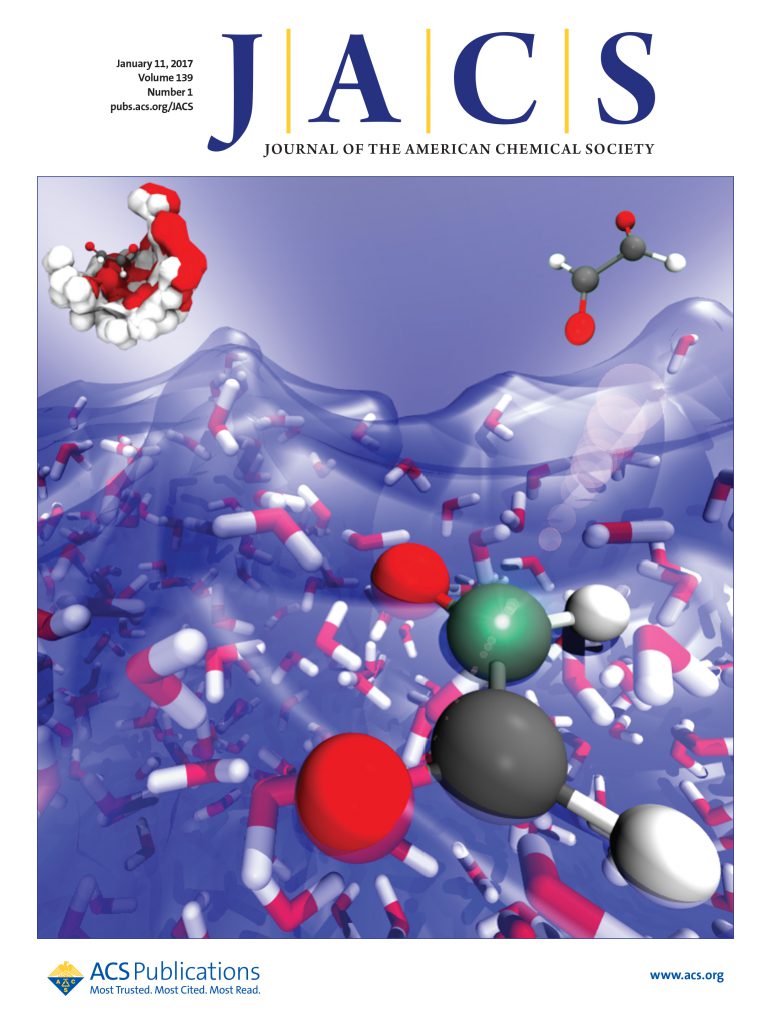利用掺杂锰的无cd量子点有效地产生有机转化中的水合电子。
IF 14.4
1区 化学
Q1 CHEMISTRY, MULTIDISCIPLINARY
引用次数: 0
摘要
光致发光材料在光照下能发射自由电子,在从先进电子源到光化学等各个领域都具有重要的技术价值。最近在掺杂Mn2+的胶体量子点(QDs)中发现了自旋交换俄歇相互作用,表明这些低成本材料具有高效光电发射的潜力。然而,以前基于cd的量子点存在固有的毒性问题,并且它们通常需要多步自旋交换俄歇相互作用来实现自由电子弹射。在这里,我们报告了Mn2+掺杂ZnSe量子点作为解决这些问题的有希望的解决方案。除了避免有毒物质,基于znse的量子点具有高能量的传导带,可以通过仅吸收两个光子来实现高效的光电发射,正如我们的飞秒瞬态吸收测量所证实的那样。第一个光子实现亚皮秒能量从光激发量子点转移到Mn2+掺杂。量子点中第二个光生电子-空穴对随后与激发掺杂剂发生亚皮秒自旋交换俄格相互作用,将能量传递给量子点电子并将其喷射到真空中。在水溶液中,这导致水合电子的量子效率超过7%。重要的是,Mn2+掺杂剂的毫秒激发态寿命使得连续波照明下的高效光电发射成为可能,这被用来驱动氯乙酸脱氯反应。本文章由计算机程序翻译,如有差异,请以英文原文为准。
Efficient Generation of Hydrated Electrons for Organic Transformations Using Manganese-Doped Cd-Free Quantum Dots.
Photoemission materials, which can emit free electrons under light illumination, hold substantial technological value in diverse fields ranging from advanced electron sources to photochemistry. Spin-exchange Auger interaction, recently discovered in Mn2+-doped colloidal quantum dots (QDs), suggests the potential of these low-cost materials for efficient photoemission. However, previous Cd-based QDs suffer from an inherent toxicity issue, and they typically require multistep spin-exchange Auger interaction to achieve free electron ejection. Here, we report Mn2+-doped ZnSe QDs as a promising solution to these issues. Besides avoiding toxic materials, ZnSe-based QDs feature a high-energy conduction band that allows for efficient photoemission by absorbing only two photons, as confirmed by our femtosecond transient absorption measurements. The first photon enacts subpicosecond energy transfer from a photoexcited QD to a Mn2+-dopant. The second photogenerated electron-hole pair in the QD subsequently undergoes subpicosecond spin-exchange Auger interaction with the excited dopant, which transfers energy to the QD electron and ejects it into the vacuum. In aqueous solution, this leads to hydrated electrons with quantum efficiency exceeding 7%. Importantly, the millisecond excited-state lifetime of Mn2+-dopants enables efficient photoemission under continuous-wave illumination, which is leveraged to drive a dechlorination reaction of chloroacetate.
求助全文
通过发布文献求助,成功后即可免费获取论文全文。
去求助
来源期刊
CiteScore
24.40
自引率
6.00%
发文量
2398
审稿时长
1.6 months
期刊介绍:
The flagship journal of the American Chemical Society, known as the Journal of the American Chemical Society (JACS), has been a prestigious publication since its establishment in 1879. It holds a preeminent position in the field of chemistry and related interdisciplinary sciences. JACS is committed to disseminating cutting-edge research papers, covering a wide range of topics, and encompasses approximately 19,000 pages of Articles, Communications, and Perspectives annually. With a weekly publication frequency, JACS plays a vital role in advancing the field of chemistry by providing essential research.

 求助内容:
求助内容: 应助结果提醒方式:
应助结果提醒方式:


